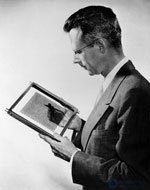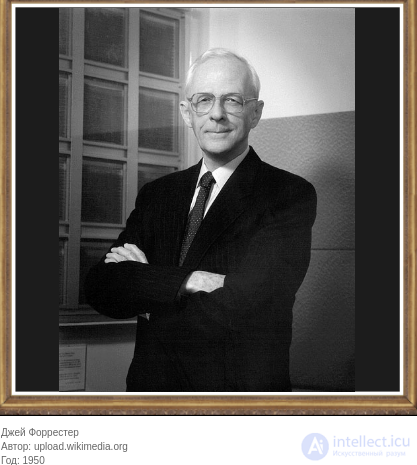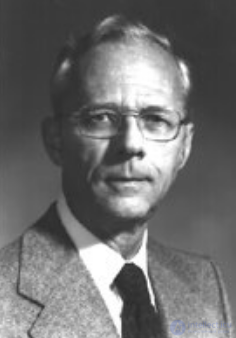Lecture



In December 1951, on Sunday evening, American television viewers in one of the TV shows saw the presentation (presentation) of the Whirlwind electronic computer. The transfer was conducted by columnist Edward Murrow (the beginning of his speech was made in the epigraph), who communicated directly with the MIT computer laboratory (Massachusetts Institute of Technology). Viewers saw on the screen something similar to words made up of illuminated lights: “HELLO, MR MURROU”. In fact, there were no light bulbs - the bright dots on the display screen, on the CRT, were glowing. For some reason, this event was later interpreted as the beginning of computer graphics.
But the main invention, which was applied in the Whirlwind computer, is random access memory on magnetic cores, acting on the principle of coincidence of currents. Supervisor Jay Forrester, tied up with cables of microphones and headphones, showed some of the possibilities of his remarkable invention to viewers.
Forrester appeared as the main person in the computer world in the late 40s - early 50s. He soon realized that computers could be used to solve various problems and therefore became one of the adherents of digital computers, defining the development of MIT in this direction, as well as the military industry and, as a result, his country. He was the organizer of one of the most significant projects in history - the “Whirlwind Project”. Air protection was deemed necessary. This need in all seriousness led to the creation of computers for the modernization of American air defense systems. Jay Forrester was chosen to solve the problem. He led the development and creation of the SAGE system. The computers of the SAGE system, being a modification of Whirlwind, were later called AN / FSQ7.
Forrester's inventions stood the test of time. The SAGE system, based on the Whirlwind computers, existed until the early 80s. At this time, Jay Forrester was already involved in new computer development in a variety of ways. He united the department at MIT with the Sloan School of Management, where he used his knowledge in computer technology to create a new discipline called system dynamics. Forrester created Whirlwind and SAGE, improved human-machine interaction, but his most significant version was magnetic memory. cores.
Talking about Forrester, one and all noted his sharp mind. At first he listened to the question, then plunged into himself for a moment and eventually gave an answer, in which there was not a single superfluous word. He was the standard of the scientist. Nevertheless, many are surprised when they find out that he was born on the cattle ranch of Claymex, near Nebraska, with a population of only 10 people. Livestock, however, did not attract him. He attended the village school and made simple experiments on electricity.
Subsequently, during his years of high school education, at senior courses, he took parts from an old car and assembled a 12-volt electrical system that operates with the help of the wind, which produced electricity on his family ranch. He wanted to enroll in an agricultural college at the University of Nebraska, but a few months before the end of 1935 he changed his mind in favor of the Faculty of Electrical Engineering. And in 1939 he graduated with the best diploma among 70 graduates of this faculty.
Forrester began research from July 1939 at the Massachusetts Institute of Technology, working first as research assistant at the High Voltage Laboratory. In the middle of the 1940/41 school year, Forrester began working in the new Servolomechanical Laboratory of Gortson Brown, which was part of the electrical engineering department of MIT. His work in the field of electrical engineering was suspended during the war in favor of research for the military industry and was completed only in 1945. Braun supervised Forrester’s work, which was called “Development of Hydraulic Servo Mechanisms”.
In December 1944, the Naval Center for Special Studies commissioned MIT to develop an Airborne Surveillance and Stability Analyzer (ASCA) to use it for new aerodynamic projects. At this time, Forrester was thinking of leaving the Servo Mechanical Laboratory, perhaps he wanted to start his own business in the field of automatic control. However, Gordon Brown wanted to keep him, offering a list consisting of twelve projects, one of which, at his discretion, he had to choose. Forrester looked through the entire list, and the thought of opening his own business seemed less attractive to him than being involved in one of the new research. The ASCA project seemed especially tempting to him. He told Brown that he chooses him.
Forrester was asked to create an analog computer that could imitate an airplane with a pilot as part of the system. Flight control must be available to the pilot, and the response of the simulation aircraft must correspond to the real time scale. The simulator's task was to quickly obtain the results of technical changes to flight data and thus save money.
Shortly after starting work on the project - it was in the spring of 1945 - Forrester realized that he was facing serious problems. In order to compare the response of the pilot in controlling the aircraft and the responses of the aircraft simulator over time, it was necessary to have an extremely high-speed device with the fastest possible time to respond. But it was not. Over the summer, Forrester concluded that an analog computer could not be fast enough to achieve a goal.
At this stage, the main turning point in Forrester’s life was his acquaintance with a man named Perry Crawford, who organized an analytical center at the Massachusetts Institute of Technology and at the same time worked at the Naval Center for Special Studies. Hearing about Forrester's problems, Crawford suggested that he study digital computing.
He also offered to introduce Forrester with scientists from Harvard and the University of Pennsylvania, and as a result Forrester in Philadelphia met John Neumann, J. Presper Eckert and other prominent scientists. This visit has made Forrester a supporter of digital computers. The next step was to convince Gordon Brown. It was easy to do, and in January 1946 he began to develop a digital computer project.
To the analog computer was lost all interest. In April of the same year, changes were made to the ASCA contract regarding the fact that Forrester and his team are going to use digital computers instead of analog computers. This project was called Whirlwind. Now Forrester becomes the director of the digital computer lab, the successor to the digital computer department of the Servo-mechanical laboratory.
In early 1947, he was trained in designing machines like EDVAC, but he concluded that the speed of their calculations did not meet the requirements of the time. Later that year, Forrester and Robert R. Ewe-rett, assistant director of the project, deviated from the main task of creating a parallel computer. Forrester was unhappy with the fact that malfunctions of the electron tubes and the crystal diodes put the Whirlwind computer down several times a day. At this stage of development, no one particularly understood the action of the electron tubes, it was only known that after 500 hours of work, most of them stopped working.
Not a single machine consisting of several thousand vacuum tubes, each of which only worked for 500 hours, was able to work long enough from breakdown to breakage. Forrester proposed two ideas that were no less serious than his memory on magnetic cores. First, it increased the life of the electron tubes to 50,000 hours, using materials for cathodes that do not contain silicone, which preclude premature losses of cathode emission. Secondly, it increased the working time tenfold — up to 5 million hours — by including the diagnostic system in the Whirlwind computer, which automatically made it possible to identify any electronic component that began to fail. He could be fixed before he could make a mistake.
Forrester and his team created a high-speed electronic digital programmable computer that corresponded to the trends of the times. He made it possible to control the flights of aircraft and could be used in the conduct of hostilities.
This computer could serve not only for calculating simulation flights, but also be used in industry and for the needs of science. Whirlwind was the most significant development of the end of the 40s - the beginning of the 50s, on which 175 people worked and for which one million dollars was spent. The developers of the project found Forrester somewhat dry and businesslike, but they had great respect for his invention. The building for Whirlwind began to be constructed in August 1948. It took up 2,500 square feet of usable space.
While working with Whirlwind, people felt that they were inside a computer: you walk along the corridor, and there are four computer devices on the right and left — four on each side. Whirlwind had only 4000 electronic tubes (for comparison, ENIAC had 17,468). Development of Whirlwind took three years, it was launched in early 1950.Whirlwind was considered the fastest computer of the 50s. He could add two 16-bit numbers in 2 milliseconds and multiply them in 20 milliseconds. The machine “Mark-G, made at Harvard, was required for multiplication of 6 seconds. Whirlwind was also superior to the ENIAC computer.
However, Whirlwind was imperfect. On 32 cathode-ray tubes (CRT) 2,048 16-bit numbers were stored. Every day the computer went down for a few hours. Memory was the weak link - each CRT for storing information served no more than a month and replacing it cost one thousand dollars. Thus, the cost of memory per month was thirty two thousand dollars.
Having improved the CRT to store information as far as possible, Forrester turned to another idea - the idea of creating a new type of memory. He saw the solution to this problem in creating a three-dimensional information storage device, since it was more compact, presented more possibilities for increasing the volume of stored information, was less expensive than one- or two-dimensional. In 1947, Forrester came up with the idea of a three-dimensional cube, where the points of intersection would be elements for storing information.
He was going to use small neon cells as elements of these intersection points, but he doubted the effectiveness of such secondary emission media. Subsequently, he postponed the project for some time, however, the idea of a three-dimensional device still stuck in his head: “From time to time I have no chance to use other elements to achieve the desired result.”
One day in the spring of 1949, he looked through the magazine Electrical Engineering and came across a description of a development called “Deltamax” made by the Germans during World War II for magnetic amplifiers used in tanks. Now it was sold to America as the main material on magnetic amplifiers. In the development of Deltamax, direct current was used to saturate the core so that current changes could be controlled. Forrester realized that this was the other way that could make nonlinear elements work in a three-dimensional device, which he had been thinking about earlier.
Forrester spent several evenings walking the streets near his suburban home, pondering the problem: "It was a challenge, another aspect of the idea, an attempt to figure out how to create a system that would allow the selection and inclusion of appropriate elements."
For a week or two he was not left with the thought of a two-dimensional device. Then he spent a few more weeks looking for a solution on how to expand the two-dimensional storage of information to three-dimensional. And the decision came to him during a horse ride on his father's ranch in Nebraska.
Returning to MIT, he ordered several Deltamax. Experiments began. He passed the current through the rings made of a special material, magnetizing them in the south and north directions. In the north direction, the device gave a unit, to the south - zero. After switching off the voltage, the rings returned to their initial state. The only problem was that Deltamax did not have the necessary speed and it was sensitive to voltage changes.
Later, under the influence of William Papian and other developers, Forrester returned to another alternative. He secured magnetic ferrite rods, bent in the form of donuts, on a grid of wires. Each rod on the grid had its coordinates (or address) - the same as on the map. In order to read or write a binary number to a magnetic memory, it was necessary to apply voltage to an exactly selected pair of horizontal and vertical rows of wires on a particular grid. The 16-bit computer had a definite place for each digit on each grid. Magnetic ferrite rings were faster, less expensive and much easier to operate than Deltamaxes.
Magnetic memory was introduced into the Whirlwind computer in the summer of 1953, after the tests were completed. As a result, Whirlwind now worked twice as fast as before. But it took three or four years before the industry realized that this was the best type of computer memory. “Then it took the next seven years,” Forrester recalled with a smile, “to convince them that they didn’t think of it first.”
The invention of Forrester increased reliability and speed at a lower cost. Starting in the early 60s, the cost of memory on magnetic cores gradually decreased. This memory allowed to enter data and commands for a few fractions of a second. Memory on magnetic cores was used until the end of the 60s, then it was replaced by semiconductor technology.
In the 50s, Whirlwind became the prototype of a whole range of computers with the help of which an advanced air defense system was created | USA - SAGE (Semiautomatic Ground Environment). From 1952 to 1956, the development of SAGE Jay Forrester.
This semi-automatic system, capable of simultaneously processing data from 23 regional centers in the United States and Canada, served a gigantic network of radars and other detectors.
In each regional center, the operator typed data on the keyboard, watching the screens that displayed weather conditions, the trajectories of the aircraft and other information necessary for the operation of the air defense system. At the same time, the network of input-output devices of the SAGE system maintained continuous communication between neighboring centers through telephone channels, uniting the system into an inseparable whole.
In July 1958, the entire SAGE system was fully implemented and fulfilled its mission for the next 25 years. The descendants of the Whirlwind computer continued to work in the system until 1983.
In 1956, when it became clear that the SAGE system was adopted and did not need his leadership, Forrester decided to take up work in another field.
Although he was still valued as a pioneer in the field of computing, he also became known as the leading theorist in the field of complex socio-economic models - the so-called field of system dynamics.
Forrester noted that in developing the SAGE system, he exercised not only technical but also administrative guidance. From the experience of working on this system, he was convinced that “technical success may depend more on the overall formulation of the case than on scientific achievements” and that “no technical experience can compensate for the poor organization of work”.
With this conviction and the feeling that “improving leadership methods is a more pressing task,” he moved to the Sloan School of MIT in July 1956. Forrester explained that, of course, computers were used at the Sloan school, especially for such purposes as operations research and processing administrative information. But, in his opinion, none of these areas "was not decisive." “The processing of business information was already rapidly developing outside the walls of MIT,” he said, “and the science of operations research dealt with simple tasks, rather than determining ways to achieve success or finding reasons for the failure of a firm’s technical policy.”
Comparing his views with the information received from managers, he found that the main problems that concern administrators are fluctuations in capital and inventories, unemployment and inflation. These and other phenomena, which are cyclical in nature, reminded the engineer Forrester of electrical oscillations, and he wondered whether, having simulated external conditions, he could find a way to establish “negative feedback” to control these oscillations. And what could be better for creating such models than computers, in the development of which he himself participated?
Thus, he was at the forefront of a new field of research, a systemic dynamics that studies “how policy changes affect growth, stability, fluctuations in level and behavior change in corporations, cities and states.”
As his confidence in the correctness of his models grew, Forrester began to speak on various issues, mainly emerging recently, such as energy shortages or long-term business cycles (this controversial phenomenon was independently predicted by his engine models).
He also spoke on issues of policy that he considered important. For example, to solve the problem of energy shortages, he proposed to change the price structure in such a way as to force the industry to abandon processes with high energy consumption.
One of the key findings of system dynamics is that the “obvious” course of action is rarely the right one; in other words, “logical” actions can give the opposite result to the desired. Based on the behavior of his models, Forrester often found himself in the role of advocate of an “anti-intuitive” problem solution. The solution for those involved in economic and social planning is obviously - you first need to “lose” your idea on the computer.
Forrester has written several serious works in this new area. “Industrial Dynamics” appeared in 1961, “Principles of the system” - in 1968. “Urban Dynamics”, published in 1969, tells of the growth and decay of cities. The world economy (1971) described the global model of economics and resource processing and analyzed the relationships among local economy, cash investments, natural resources, environmental pollution, food security, and living standards.
Comments
To leave a comment
Persons
Terms: Persons